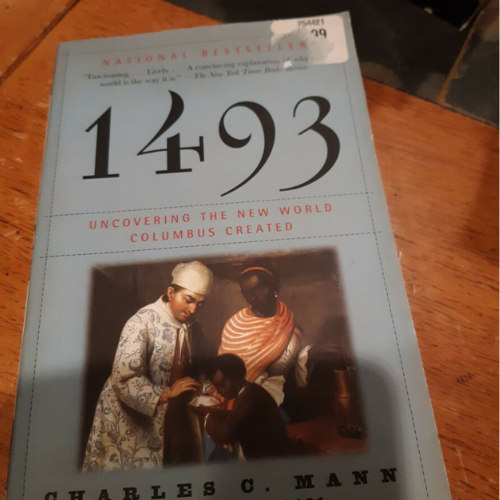Opening Book
BOOK 1493
The Complete Saga of Binance's Rise to Meme Supremacy
✧
Charles C. Mann
Chapter 1: One World
Part One reveals how Columbus’s 1492 voyage shattered the barriers between continents, sparking a global swap of crops, cultures, and chaos.
Columbus’s arrival in the Caribbean didn’t just mark a discovery—it unleashed a flood of exchanges that reshaped ecosystems and societies.
From maize to smallpox, the Old and New Worlds collided, creating a single, interconnected planet.
Explore the birth of globalization through the triumphs and tragedies of first encounters.
Columbus’s arrival in the Caribbean didn’t just mark a discovery—it unleashed a flood of exchanges that reshaped ecosystems and societies.
From maize to smallpox, the Old and New Worlds collided, creating a single, interconnected planet.
Explore the birth of globalization through the triumphs and tragedies of first encounters.
4
Chapter 2: The Bear Market and Solana's Rise
Tobacco, that outlandish weed, became the economic foundation of the Chesapeake, just as disease became its hidden architect.
Part Two traces the Atlantic’s transformation as American crops and deadly diseases fueled Europe’s colonies and the slave trade.
Tobacco turned Virginia into a cash-crop empire, but its success rested on ravaged lands and enslaved labor.
Malaria and yellow fever, carried across oceans, decimated Indigenous peoples and shaped who worked the New World’s fields.
Dive into the gritty story of how greed and germs built the Americas’ first settlements.
Part Two traces the Atlantic’s transformation as American crops and deadly diseases fueled Europe’s colonies and the slave trade.
Tobacco turned Virginia into a cash-crop empire, but its success rested on ravaged lands and enslaved labor.
Malaria and yellow fever, carried across oceans, decimated Indigenous peoples and shaped who worked the New World’s fields.
Dive into the gritty story of how greed and germs built the Americas’ first settlements.
5
Chapter 3: Solana's Collapse
Silver from American mines poured into China, knitting together a world economy no one could have imagined.
Part Three follows the Pacific’s rise as a global highway, where American silver and crops like potatoes and maize reshaped Asia.
Potosí’s silver mines flooded markets from Manila to Beijing, tying distant empires in trade.
New World crops fed millions, turning barren lands into thriving farms across China and beyond.
Uncover how the Pacific became the artery of a new global order.
The Pacific’s rise as a global artery, driven by American silver and crops, didn’t just reshape economies—it created the first truly global system.
Potosí’s silver linked a peasant in China to a merchant in Spain.
Part Three follows the Pacific’s rise as a global highway, where American silver and crops like potatoes and maize reshaped Asia.
Potosí’s silver mines flooded markets from Manila to Beijing, tying distant empires in trade.
New World crops fed millions, turning barren lands into thriving farms across China and beyond.
Uncover how the Pacific became the artery of a new global order.
The Pacific’s rise as a global artery, driven by American silver and crops, didn’t just reshape economies—it created the first truly global system.
Potosí’s silver linked a peasant in China to a merchant in Spain.
6
Chapter 4: CZ's Masterstroke – BSC’s Comeback
The introduction of American crops like potatoes and maize to Europe wasn’t just a culinary shift—it was a demographic and economic revolution.
The potato, more than any king, made Europe’s population explode, but its fragility brought catastrophe.
Part Four shows how American crops and resources supercharged Europe’s growth, while exposing its reliance on nature’s whims.
Potatoes and maize fed millions, paving the way for cities, armies, and industries.
Rubber and quinine powered colonial empires, but their harvests scarred landscapes forever.
Discover Europe’s ascent through the lens of American biology.
The potato, more than any king, made Europe’s population explode, but its fragility brought catastrophe.
Part Four shows how American crops and resources supercharged Europe’s growth, while exposing its reliance on nature’s whims.
Potatoes and maize fed millions, paving the way for cities, armies, and industries.
Rubber and quinine powered colonial empires, but their harvests scarred landscapes forever.
Discover Europe’s ascent through the lens of American biology.
7
Chapter 5: Africa in the World
Africans, torn from their homes, forged new worlds in the Americas, their defiance as vital as their labor.
The slave trade’s brutality mixed African traditions with New World realities, creating vibrant, hybrid societies.
Maroon communities, built by escapees, stood as beacons of resistance against oppression.
Part Five of Charles C. Mann’s 1493 shifts focus to Africa’s profound influence on the Americas through the lens of the Columbian Exchange, emphasizing the slave trade, cultural fusion, and resistance.
The slave trade didn’t just exploit—it populated.
They forged new worlds despite unimaginable odds.
The slave trade’s brutality mixed African traditions with New World realities, creating vibrant, hybrid societies.
Maroon communities, built by escapees, stood as beacons of resistance against oppression.
Part Five of Charles C. Mann’s 1493 shifts focus to Africa’s profound influence on the Americas through the lens of the Columbian Exchange, emphasizing the slave trade, cultural fusion, and resistance.
The slave trade didn’t just exploit—it populated.
They forged new worlds despite unimaginable odds.
8
EPILOGUE
The Columbian Exchange has left us with not just a richer but a more impoverished planet, and its currents still shape our lives.
Reflect on how history’s tides still ripple, urging us to rethink our place in a world born in 1492.
Reflect on how history’s tides still ripple, urging us to rethink our place in a world born in 1492.
9
TOKENOMICS
Above are 5 for the Epilogue page, including one key quote, an overview, and supporting sentences to highlight its significance. They’re crafted to draw visitors into the book’s final thoughts and encourage reflection, ideal for a website’s narrative flow.
TOTAL SUPPLY : 1,000,000,000
OWNERSHIP : RENOUNCED
LP BURNT

TOTAL SUPPLY : 1,000,000,000
OWNERSHIP : RENOUNCED
LP BURNT

10
"The ultimate chronicle of ETH's journey from utility token to meme market royalty."

ISBN 978-3-16-148410-0